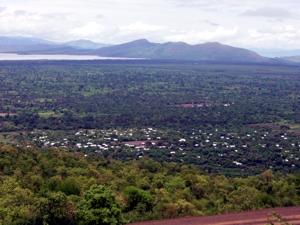Rifts and mountain building
Volcanic structure produced by a phreatomagmatic eruptions. Tres Cruces Volcanic Center. Ring tuff. Salta Rift, Cretaceous, Argentina
Image Credit: MBG
Ethiopian Rift Valley near Lake Abaya
Image Credit: MBG
Less spectacular formation of mountains, involving magma addition into the Earth’s surface, occurs along incipient spreading centers, oceanic ridges and (continental) rifts. Oceanic ridges occur at divergent boundaries where plates separate and move in opposite directions, allowing new lithosphere to form from upwelling magma, which rises up due to convection currents. The intrusion of these magmas most probably results from decompression melting of mafic rocks, giving rise to the formation new oceanic crust. Key areas include Iceland (where a spreading ridge coincides with a hot spot and therefore became emergent above sea level), the Mid-Atlantic Ridge along the Atlantic’s sea floor, and the East Pacific Rise.
Continental rifts also result from extension, which may eventually include the creation of oceanic crust and evolve into oceanic spreading centers. The Red Sea region shows a successful evolution of oceanic spreading from a continental rift, while the East African Rift Valley and the Rio Grande Rift in the USA are good examples of continental rifts which may or may not develop into oceanic spreading centers, depending on the degree of mantle upwelling below the zone of extension. Mantle upwelling may result in decompression melting of mantle material and could induce crustal anatexis. Rifts are also the precursors of passive continental margins. Along passive margins, no or very little tectonic deformation is taking place because they are not close to (active) plate boundaries.
Magmatism along continental rifts is generally of small volume and of a specific age. The volcanics usually show diverse composition because they are not sourced from a single large heat source. Therefore, no single composition dominates along the geographic extent of the rift or with time.

